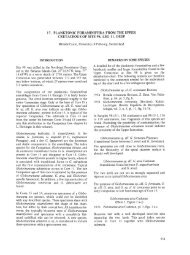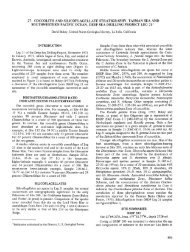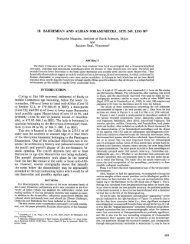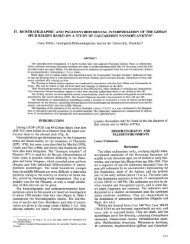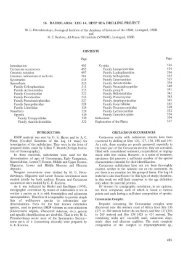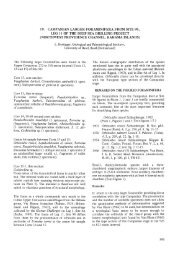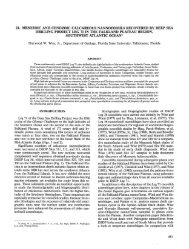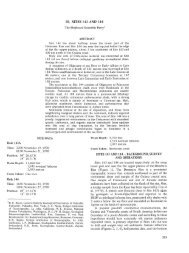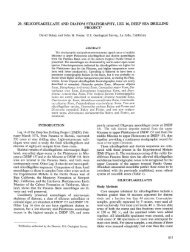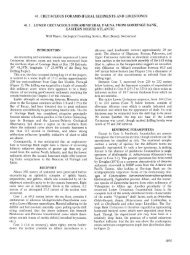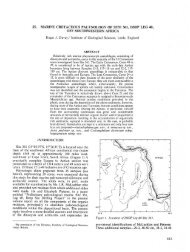12. Upper Maestrichtian and Paleocene Planktonic Foraminiferal ...
12. Upper Maestrichtian and Paleocene Planktonic Foraminiferal ...
12. Upper Maestrichtian and Paleocene Planktonic Foraminiferal ...
You also want an ePaper? Increase the reach of your titles
YUMPU automatically turns print PDFs into web optimized ePapers that Google loves.
<strong>12.</strong> UPPER MAESTRICHTIAN AND PALEOCENE PLANKTONIC FORAMINIFERAL<br />
BIOSTRATIGRAPHY OF THE NORTHERN CAPE BASIN,<br />
DEEP SEA DRILLING PROJECT HOLE 524 1<br />
C. C. Smith, 2 U.S. Geological Survey, Washington, D.C.<br />
<strong>and</strong><br />
R. Z. Poore, U.S. Geological Survey, Reston, Virginia<br />
ABSTRACT<br />
Examination of <strong>Maestrichtian</strong> <strong>and</strong> <strong>Paleocene</strong> planktonic foraminiferal assemblages from DSDP Leg 73, Hole 524,<br />
revealed an exp<strong>and</strong>ed <strong>and</strong> apparently continuous sequence of sediments across the Cretaceous/Tertiary boundary.<br />
Within the <strong>Upper</strong> Cretaceous section, Core 28 is assigned to the upper part of the Globotruncana gansseri Subzone of<br />
late middle <strong>Maestrichtian</strong> age, <strong>and</strong> Cores 27 through 21 are assigned to the Abathomphalus mayaroensis Subzone of<br />
late <strong>Maestrichtian</strong> age. The lower portion of Core 20 is assigned to the "Globigerina eugubina" Zone, <strong>and</strong> the upper<br />
part of Core 20 is assigned to the Subbotina pseudobulloides Zone. Integration of these data with the Cretaceous/Tertiary<br />
boundary in Hole 524 as defined by calcareous nannofossil biostratigraphy indicates that part of the<br />
"G. eugubina" Zone is of late <strong>Maestrichtian</strong> rather than early Danian age. Paleomagnetic analysis of Hole 524 shows<br />
that the paleontologic Cretaceous/Tertiary boundary occurs in the reversed portion of Chron C-29.<br />
INTRODUCTION<br />
Site 524 is located in the northern Cape Basin on a<br />
submarine fan derived from a submarine canyon cut into<br />
the Walvis Ridge (29°29'S, 3°31'E; water depth,<br />
4796 m.). Three holes were cored at Site 524. Hole 524,<br />
which was drilled with conventional rotary techniques,<br />
was spot cored in the upper 47.5 m <strong>and</strong> then continuously<br />
cored below 47.5 m sub-bottom. In Hole 524A,<br />
two conventional cores were recovered from the top of<br />
the sedimentary section. In Hole 524B, which was offset<br />
100 ft. from Hole 524A, attempts were made to acquire<br />
seven cores with the hydraulic piston corer (HPC). Core<br />
recovery was erratic, however, <strong>and</strong> coring disturbance<br />
was common. The cores recovered from Hole 524A <strong>and</strong><br />
Cores 1 through 3 of Hole 524 were also too disturbed<br />
for magnetic polarity analysis. Cores 4 through 28 of<br />
Hole 524, however, recovered an exp<strong>and</strong>ed sedimentary<br />
section that yielded a reliable magnetic polarity record<br />
<strong>and</strong> contained stratigraphically diagnostic planktonic<br />
foraminifers. The purpose of this contribution is to establish<br />
the occurrence of the stratigraphically diagnostic<br />
foraminifers in Cores 4 through 28 of Hole 524 <strong>and</strong> to<br />
discuss the rationale for the age <strong>and</strong> zone assignments.<br />
HOLE 524 SEDIMENTS<br />
The sediments recovered in Cores 4 through 28 of<br />
Hole 524 vary from nannofossil chalk <strong>and</strong> marl to claystone<br />
to bioclastic <strong>and</strong> volcaniclastic s<strong>and</strong>stones. Turbidites<br />
derived from the nearby Walvis Ridge comprise<br />
much of the section, <strong>and</strong> the large turbidite component<br />
results in an average accumulation rate of about 30<br />
m/m.y. Reworking was noted in many samples, <strong>and</strong><br />
1<br />
Hsü, K. J., LaBrecque, J. L., et al., Init. Repts. DSDP, 73: Washington (U.S. Govt.<br />
Printing Office).<br />
2 Present address: Tenneco Oil Co., Houston, Texas.<br />
foraminifers are poorly preserved in several intervals.<br />
Because of the problems with reworking <strong>and</strong> preservation,<br />
the section from Hole 524 was sampled only in<br />
enough detail to provide a basis for the correlation of<br />
the foraminiferal biostratigraphy with the magnetic<br />
polarity record. The correlation between the magnetostratigraphy<br />
<strong>and</strong> biostratigraphy in Hole 524 is summarized<br />
by Poore et al. (this vol.).<br />
The stratigraphic occurrences of the foraminiferal<br />
taxa identified in Hole 524 samples are plotted in<br />
Table 1. Abundance estimates were derived by examining<br />
washed residues equal to or greater than 63 µm in<br />
size. The categories used in Table 1 are defined as follows<br />
in terms of the number of specimens per sample:<br />
VR (very rare)—1 to 2; R (rare)—3 to 5; C (common)—<br />
6 to 10; A (abundant)—11 to 50; <strong>and</strong> VA (very abundant)—50<br />
or more.<br />
The foraminiferal zonations follow Pessagno (1967)<br />
for the Cretaceous <strong>and</strong> Stainforth et al. (1975) for the<br />
<strong>Paleocene</strong>.<br />
<strong>Maestrichtian</strong> Biostratigraphy<br />
The planktonic foraminifers recovered from the <strong>Maestrichtian</strong><br />
section of Hole 524 vary considerably in occurrence<br />
<strong>and</strong> relative abundance (Table 1), with obvious indications<br />
of reworking particularly prevalent at <strong>and</strong><br />
near the <strong>Maestrichtian</strong>/Danian boundary. The lowermost<br />
sample observed to contain Cretaceous planktonic<br />
foraminifers was Sample 28,CC, which yielded very rare<br />
individuals of Heterohelix glabrans (Cushman). Underlying<br />
sediments (Samples 524-29-1, 55-57 cm, 524-<br />
29,CC, <strong>and</strong> 524-32-2, 54-56 cm) proved to be barren of<br />
planktonic foraminifers. The presence of H. glabrans<br />
(Cushman) in Sample 28,CC, as well as the fauna recovered<br />
from overlying samples in Core 28, including<br />
Planoglobulina brazoensis Martin, plicate Globotruncana<br />
contusa (Cushman), <strong>and</strong> the very rare presence of<br />
449
C. C. SMITH, R. Z. POORE<br />
Table 1. Occurrence <strong>and</strong> relative abundance of planktonic foraminifers in Cores 4 to 32 of Hole 524.<br />
Stage<br />
i<br />
Danian 1 Thanetian<br />
late<br />
<strong>Maestrichtian</strong><br />
middle<br />
<strong>Maestrichtian</strong><br />
Zone/<br />
subzone<br />
P. pseudomenardii<br />
Zone<br />
52<br />
^> o<br />
S N<br />
N
Table 1. (Continued).<br />
PLANKTONIC FORAMINIFERAL BIOSTRATIGRAPHY, HOLE 524<br />
-5. triangularis<br />
- S. triloculinoides<br />
S. trinidadensis<br />
S. velascoensis<br />
Reworked Cretaceous<br />
-Abathomphalus intermedius<br />
-A. mayaroensis<br />
- Globigerinelloides multispina<br />
- G. prairlehillensis<br />
G. subcarinatus<br />
Globotruncana aegyptiaca<br />
G. area<br />
G. conica<br />
-G. contusa<br />
G. duwi<br />
-G. elevata<br />
-G. gansseri<br />
-G. navarroensis<br />
- G. patelliformis<br />
-G. plummerae<br />
-G. Stephensoni<br />
-G. stuarti<br />
-G. stuarti formis<br />
-G. trinidadensis<br />
-Globotruncanella petal oidea<br />
- Gublerina ornatissima<br />
-G. robusta<br />
-Guembelitria cretacea<br />
-Heteroheli× glabrans<br />
-H. globulosa<br />
-H. navarroensis<br />
-H. pulchra<br />
•H. striata<br />
-Planoglobulina brazoensis<br />
-P. carseyae<br />
-Pseudoguembelina costulata<br />
-P. e×colata<br />
-Pseudote×tularia deformis<br />
-P. elegans<br />
-P. intermedja<br />
- Racemiguembelina fructicosa<br />
~R. powelli<br />
-Rugoglobigerina he×acamerata<br />
-R. macrocephala<br />
-R. milamensis<br />
~R. pennyi<br />
-R. rotundata<br />
-R. rugosa<br />
- Ventilabrella multicamerata<br />
-V. riogr<strong>and</strong>ensis<br />
c<br />
A VA<br />
VA<br />
VA<br />
VA<br />
A<br />
VA<br />
RVAC<br />
RVAC<br />
A R<br />
C<br />
VA<br />
R<br />
C<br />
R<br />
a<br />
a a a<br />
o a a o<br />
R<br />
CVR<br />
R C C<br />
RVR VRVR C<br />
R<br />
VR<br />
VR C C R<br />
A<br />
R<br />
VR<br />
C<br />
R VRVR<br />
C<br />
VR R<br />
R<br />
VR<br />
VR<br />
R C VR A R A CVR A R CVF R R<br />
VR<br />
VA R C R R<br />
C A<br />
C R C R VAR R C | /RVRVRR VRA A R<br />
R C A A C A VFR<br />
C R<br />
VR A A A<br />
C C C C A R VR<br />
VR<br />
C R R VR VRVFt<br />
C A C<br />
RVF VR VR VR R<br />
C<br />
R R A<br />
VRVR<br />
R A A<br />
VRVR<br />
R CVR<br />
R C<br />
C VR<br />
C<br />
C VR<br />
only be defined as lying within the interval between<br />
Sample 524-28-2, 12-14 cm <strong>and</strong> Sample 524-26,CC.<br />
The abundant, diverse, <strong>and</strong> well preserved planktonic<br />
foraminiferal fauna recovered from Sample 26,CC<br />
through Core 21 is herein assigned to the A mayaroensis<br />
Subzone, which is late <strong>Maestrichtian</strong> in age. The<br />
VR<br />
C C<br />
RA R<br />
R<br />
R<br />
VRR<br />
C R<br />
VR<br />
VR<br />
R A<br />
VR<br />
R<br />
R<br />
VR<br />
R<br />
VR<br />
R R<br />
C<br />
VRC<br />
C R VR<br />
AC C<br />
C C<br />
m<br />
R<br />
R C<br />
VRVR VR R<br />
C R<br />
VR<br />
VR<br />
VR<br />
VR R<br />
A R<br />
VR<br />
R R<br />
RVR<br />
I/R VR<br />
C<br />
R<br />
VF<br />
C<br />
R R C<br />
R<br />
VR<br />
VR<br />
R<br />
VR<br />
C R VR<br />
R<br />
R R R C R R VR C<br />
A R C VRV/ R A<br />
C C RVRR R VRVR R A VRR VAVRVR<br />
C A C VR R R C AVRVA<br />
C C R VR R C RVRR<br />
C A VR<br />
C<br />
VR<br />
VR<br />
VRR C R R<br />
fauna within this interval contains typical <strong>and</strong> morphologically<br />
advanced forms ofR. fructicosa, rare individuals<br />
of G. conica, morphologically advanced <strong>and</strong> very<br />
highly plicate G. contusa, rare to common individuals<br />
of G. stuarti, <strong>and</strong> both A. intermedius <strong>and</strong> rare to common<br />
large <strong>and</strong> well developed A. mayaroensis.<br />
451
C. C. SMITH, R. Z. POORE<br />
Late <strong>Maestrichtian</strong> planktonic foraminifers extend<br />
upward from Core 27 through Core 20 <strong>and</strong> continue to<br />
be present sporadically as high as Core 6. These <strong>Maestrichtian</strong><br />
species (see Table 1) co-occur with undeniable<br />
Danian species in the upper part of Core 20, <strong>and</strong> a progressively<br />
younger <strong>Paleocene</strong> fauna up through Core 6.<br />
Intensive <strong>and</strong> detailed investigations of the calcareous<br />
nannofossil flora from Hole 524 by Percival (this vol.)<br />
have found that the Cretaceous/Tertiary boundary is at<br />
Sample 524-20-3, 105 cm. Thus, it seems evident that<br />
the late <strong>Maestrichtian</strong> fauna in the upper part of Core<br />
20 through Core 6 has been either reworked in situ into<br />
overlying sediments of early <strong>Paleocene</strong> age or that the<br />
mixed foraminiferal fauna is the result of paleoslope instability<br />
<strong>and</strong> turbidite activity. In either case, the highest<br />
occurrence of undeniable <strong>Upper</strong> Cretaceous species cannot<br />
be used as a reliable guide in marking the <strong>Maestrichtian</strong>/Danian<br />
boundary in Hole 524.<br />
<strong>Paleocene</strong> Biostratigraphy<br />
Indications of <strong>Paleocene</strong> taxa are first seen in Sample<br />
524-21-4, 26-28 cm, where minute representatives of<br />
"Globigerina eugubina" (s.l.) Luterbacher <strong>and</strong> Premoli<br />
Silva occur with Chiloguembelina taurica Morozova.<br />
Most of the individuals included in "G. eugubina" (s.l.)<br />
are morphologically similar to "G. fringa" Subbotina<br />
(see Plate 1). Additions to the "<strong>Paleocene</strong>" fauna in the<br />
lower part of Core 20 (Samples 524-20,CC <strong>and</strong> 524-20-3,<br />
4-7 cm) include "G. simplicissima" (Blow) <strong>and</strong> forms<br />
very close to Globoconusa daubjergensis (Brönnimann).<br />
Sample 524-20-1, 34-37 cm contains typical G. daubjergensis<br />
<strong>and</strong> forms similar to Subbotina pseudobulloides<br />
(Plummer), whereas S. inconstans (Subbotina) <strong>and</strong> typical<br />
S. pseudobulloides are present in samples from Core<br />
19. Cretaceous planktonic foraminifers occur in all<br />
samples from Cores 21 <strong>and</strong> 20 but are rare in Sample<br />
524-20-1, 34-37 cm.<br />
The zonation of assemblages from Cores 21 <strong>and</strong> 20 is<br />
equivocal. The fauna from the top of Core 20 is too advanced<br />
<strong>and</strong> diverse to be of basal Danian age <strong>and</strong> is assigned<br />
to the S. pseudobulloides Zone. The lower part<br />
of Core 20 is assigned to the "Globigerina eugubina"<br />
Zone, <strong>and</strong> Core 21 is assigned to the Abathomphalus<br />
mayaroensis Subzone. Alternatively, the occurrence of<br />
"G. eugubina" <strong>and</strong> C. taurica in Sample 524-21-4,<br />
26-28 cm could be used to assign most of Core 21 to the<br />
"G. eugubina" Zone.<br />
Detailed study of calcareous nannofossils in Hole 524<br />
(Percival, this vol.; Hsü et al., 1982) indicates that the<br />
Cretaceous/Tertiary boundary occurs at 105 cm in Section<br />
3 of Core 20. Placement of the Cretaceous/Tertiary<br />
boundary at this level is supported by the presence of an<br />
iridium anomaly (Hsü et al., 1982). Thus, data from<br />
Hole 524 indicate that "Globigerina eugubina" (s.l.)<br />
<strong>and</strong> C. taurica range down into the Cretaceous.<br />
The assemblage from Sample 524-17-3, 80-82 cm<br />
contains specimens similar to S. trinidadensis, <strong>and</strong> this<br />
occurrence is used to approximate the lower limit of the<br />
S. trinidadensis Zone. S. trinidadensis is not well developed<br />
in Hole 524 assemblages, however, <strong>and</strong> an alternative<br />
interpretation would be to use the occurrence of<br />
452<br />
S. inconstans in Core 19 to approximate the base of the<br />
5. trinidadensis Zone between Cores 19 <strong>and</strong> 20.<br />
S. pseudobulloides <strong>and</strong> S. triloculinoides (Plummer)<br />
are consistently abundant in assemblages from Cores 17<br />
through <strong>12.</strong> The lowest occurrences of Morozovella uncinata<br />
(Bolli), M. pusilla (Bolli), <strong>and</strong> Planorotalites<br />
pseudomenardii (Bolli) mark the lower limits of the M.<br />
uncinata, M. pusilla, <strong>and</strong> P. pseudomenardii Zones.<br />
Note that M. angulata (White), M. conicotruncata (Subbotina),<br />
<strong>and</strong> M. pusilla (Bolli) all have their lowest occurrence<br />
in Sample ll.CC. Rather than presume an<br />
unconformity, we infer that the M. angulata Zone is<br />
present in the unsampled interval of Core <strong>12.</strong> M. conicotruncata<br />
is a prominent component of the diverse assemblages<br />
from Cores 11 through 9. <strong>Planktonic</strong> foraminiferal<br />
assemblages in Cores 8 through 4 are generally<br />
poorly preserved <strong>and</strong> are dominated by small representatives<br />
of Acarinina. Planorotalites is not well represented<br />
in these assemblages, <strong>and</strong> thus the base of the P.<br />
pseudomenardii Zone may actually occur lower in the<br />
section.<br />
SUMMARY<br />
An exp<strong>and</strong>ed <strong>and</strong> apparently continuous section from<br />
the <strong>Maestrichtian</strong> Globotruncana gansseri Subzone to<br />
the <strong>Paleocene</strong> Planorotalites pseudomenardii Zone was<br />
recovered in DSDP Hole 524. With the exception of the<br />
Morozovella angulata Zone, all of the st<strong>and</strong>ard lowlatitude<br />
foraminiferal zones are recognized; the M. angulata<br />
Zone is inferred to occur in an unsampled interval.<br />
Although the precise positions of several boundaries<br />
are cannot be determined, data from Hole 524 allow<br />
the direct calibration of st<strong>and</strong>ard foraminiferal zonations<br />
to latest Cretaceous <strong>and</strong> <strong>Paleocene</strong> magnetic polarity<br />
history.<br />
REFERENCES<br />
Beckman, J. P., 1957. Chiloguembelina Loeblich <strong>and</strong> Tappan <strong>and</strong> related<br />
Foraminifera from the lower Tertiary of Trinidad, B.W.I.<br />
U.S. Nat. Mus. Bull., 215:83-95.<br />
Berggren, W. A., 1977. Atlas of Palaeogene planktonic Foraminifera.<br />
In Ramay, A. T. S. (Ed.), Oceanic Micropalaeontology (Vol. 1):<br />
London (Academic Press Inc.), 205-300.<br />
Blow, W. H., 1979. The Cainozoic Globigerinida: Leiden (E. J. Brill).<br />
Bolli, H. M., 1951. The genus Globotruncana in Trinidad, B.W.I. J.<br />
Paleontol., 25:187-199.<br />
, 1957. The genera Globigerina <strong>and</strong> Globorotalia in the <strong>Paleocene</strong>-Lower<br />
Eocene Lizard Springs Formation of Trinidad, B.<br />
W. I. U.S. Nat. Mus. Bull., 215:61-81.<br />
Brönnimann, P., 1952a. Globigerinidae from the <strong>Upper</strong> Cretaceous<br />
(Cenomanian-<strong>Maestrichtian</strong>) of Trinidad, B. W. I. Bull. Am.<br />
Paleontol., 34:5-50.<br />
, 1952b. Trinidad <strong>Paleocene</strong> <strong>and</strong> Lower Eocene Globigerinidae.<br />
Bull. Am. Paleontol., 34:1-35.<br />
., 1953. Note on planktonic Foraminifera from Danian localities<br />
of Jutl<strong>and</strong>, Denmark. Eclogue Geol. Helv., 45:339-341.<br />
Brotzen, F., 1934. Foraminiferen aus dem Senon Palástinas. Dtsch.<br />
Ver. Palástinas, 57:28-72.<br />
, 1936. Foraminiferen aus dem schwedischen untersten Senon<br />
von Eriksdal in Schonen. Sver. Geol. Unterst., 396:1-206.<br />
Cushman, J. A., 1925. Some new Foraminifera from the Velasco<br />
Shale of Mexico. Contrib. Cushman Lab. <strong>Foraminiferal</strong> Res., 1:<br />
18-23.<br />
, 1926. Some Foraminifera from the Mendez Shale of eastern<br />
Mexico. Contrib. Cushman Lab. <strong>Foraminiferal</strong> Res., 2:16-26.<br />
, 1933. Some new foraminiferal genera. Contrib. Cushman<br />
Lab. <strong>Foraminiferal</strong> Res., 9:32-38.
, 1938. Cretaceous species of Gumbelina <strong>and</strong> related genera.<br />
Contrib. Cushman Lab. <strong>Foraminiferal</strong> Res., 14:2-28.<br />
, 1940. Midway Foraminifera from Alabama. Contrib. Cushman<br />
Lab. <strong>Foraminiferal</strong> Res., 16:51-73.<br />
_, 1946. <strong>Upper</strong> Cretaceous foraminifera of the Gulf Coastal<br />
region of the United States <strong>and</strong> adjacent areas. Geol. Surv. Prof.<br />
Pap. U.S., 206:1-241.<br />
Cushman, J. A., <strong>and</strong> Church, C. C, 1929. Some <strong>Upper</strong> Cretaceous<br />
foraminifera from near Coalinga, California. Proc. Calif. Acad.<br />
Sci., 18:497-530.<br />
Cushman, J. A., <strong>and</strong> Renz, H. H., 1942. Eocene, Midway, Foraminifera<br />
from Soldado Rock, Trinidad. Contrib. Cushman Lab. <strong>Foraminiferal</strong><br />
Res. ,18:1-20.<br />
Dalbiez, F., 1955. The genus Globotruncana in Tunisia. Micropaleontology,<br />
1:161-171.<br />
de Klasz, I., 1953. Einige neue oder wenig bekannte Foraminiferen<br />
aus der helvetischen Oberkreide der bayerischen Alpen südlich<br />
Traunstein (Oberbayern). Geol. Bavarica, 17:233-244.<br />
de Lapparent, J., 1918. Etude lithologique des terrains Crétaces de la<br />
region d'Hendaye, Serv. Carte Geol. Fr. Mem.: 1-153.<br />
Egger, J. G., 1899. Foraminiferen und ostrakoden aus den Kreidemergeln<br />
der oberbayerischen Alpen. K. Bayer Akad. Wiss., München,<br />
Math.-Phys. Ci, 21:3-230.<br />
Ehrenberg, C. G., 1840. Die bildung der Europaischen, Libyschen<br />
und Arabischen Kreidefelsen und des Kreidemergels aus mikroskopischen<br />
Organismen. Abh. Preuss. Akad. Wiss., München, pp.<br />
1-91.<br />
Finlay, H. J., 1947. New Zeal<strong>and</strong> Foraminifera: key species in stratigraphy.<br />
N. Z. J. Sci. Technol., B28, 5:259-292.<br />
G<strong>and</strong>olfi, R., 1955. The genus Globotruncana in northeastern Colombia.<br />
Bull. Am. Paleontol., 36:7-118.<br />
Glaessner, M. F., 1937. Studien über Foraminiferen aus der Kreide<br />
und dem Tertiàr des Kaukasus. Probl. Paleontol., Moscow Univ.<br />
Lab. Paleontol., 2-3:349-410.<br />
Hsü, K. J., He, Q., McKenzie, J. A., Weissert H., Perch-Nielsen, K.,<br />
Oberhànsli, H., Kelts, K., LaBrecque, J., Tauxe, L., Kràhenbühl,<br />
U., Percival, S. F., Wright, R., Karpoff, A., Petersen, N.,<br />
Tucker, P., Poore, R., Gombos, A., Pisciotto, K., Carman, M.<br />
F., <strong>and</strong> Schreiber, E., 1982. Mass mortality <strong>and</strong> its environmental<br />
<strong>and</strong> evolutionary consequences. Science, 216:249-256.<br />
Khalilov, D. M., 1956. O pelagicheskoj faune foraminifer Paleogenovykh<br />
otlozhenij Azerbajdzhana. Akad. Nauk Azerbaidzhan, 17:<br />
234-255.<br />
Kikoine, J., 1948. Les Heterohelicidae du Crétace superieur pyrénéen.<br />
Bull. Soc. Géol. Fr., 18:15-35.<br />
Krasheninnikov, V. A., <strong>and</strong> Hoskins, R. H., 1973. Late Cretaceous<br />
Paleogene <strong>and</strong> Neogene planktonic foraminifera. In Heezen, B.<br />
C, MacGregor, I. D., et al., Init. Repts. DSDP, 20: Washington<br />
(U.S. Govt. Printing Office), 105-203.<br />
Lalicker, C. G., 1948. A new genus of foraminifera from the <strong>Upper</strong><br />
Cretaceous. J. Paleontol., 22:624.<br />
LeRoy, L. W., 1953. Biostratigraphy of the Maqfi section, Egypt.<br />
Mem. Geol. Soc. Am., 54:1-73.<br />
Loeblich, A. R., Jr., 1951. Coiling in the Heterohelicidae. Contrib.<br />
Cushman Found. <strong>Foraminiferal</strong> Res., 18:106-111.<br />
Loeblich, A. R., Jr., <strong>and</strong> Tappan, H., 1957. <strong>Planktonic</strong> Foraminifera<br />
of <strong>Paleocene</strong> <strong>and</strong> early Eocene age from the Gulf <strong>and</strong> Atlantic<br />
Coastal Plains. U.S. Nat. Mus. Bull., 215:173-198.<br />
Lowrie, W., <strong>and</strong> Alvarez, W., 1977. <strong>Upper</strong> Cretaceous-<strong>Paleocene</strong><br />
magnetic stratigraphy at Gubbio, Italy. III. <strong>Upper</strong> Cretaceous<br />
magnetic stratigraphy. Geol. Soc. Am. Bull., 88:374-377.<br />
Luterbacher, H., <strong>and</strong> Premoli Silva, I., 1964. Biostratigrafia del limite<br />
Cretaceo-Terziario neU'Appennino centrale. Riv. Ital. Paleontol.<br />
Stratigraf, 70:67-128.<br />
Martin, L. T., 1943. Eocene Foraminifera from the type Lodo Formation,<br />
Fresno County, California. Stanford Univ. Publ. Geol. Sci.,<br />
3:93-125.<br />
Martin, S. E., 1972. Reexamination of the <strong>Upper</strong> Cretaceous planktonic<br />
foraminiferal genus Planoglobulina Cushman <strong>and</strong> Ventilabrella<br />
Cushman. J. <strong>Foraminiferal</strong> Res., 2:73-92.<br />
Morozova, V. G., <strong>and</strong> Moskalenko, T. A., 1961. Foraminifères planctoniques<br />
des depots limitrophes du Bajocien et du Daghestan central<br />
(nord-est du Caucase). Acad. Nauk. SSR Vopr. Mikropaleontol.,<br />
5:3-30.<br />
PLANKTONIC FORAMINIFERAL BIOSTRATIGRAPHY, HOLE 524<br />
Nakkady, S. E., 1950. A new foraminiferal fauna from the Esna<br />
Shales <strong>and</strong> <strong>Upper</strong> Cretaceous Chalk of Egypt. /. Paleontol., 24:<br />
675-692.<br />
Pessagno, E. A., Jr., 1967. <strong>Upper</strong> Cretaceous planktonic foraminifera<br />
from the western Gulf Coastal Plain. Paleontographica Americana,<br />
5:245-445.<br />
Plummer, H. J., 1926. Foraminifera of the Midway Formation in<br />
Texas. Univ. Tex. Bull., 2644:1-206.<br />
, 1931. Some Cretaceous foraminifera in Texas. Univ. Tex.<br />
Bull., 3101:109-203.<br />
Premoli Silva, I., <strong>and</strong> Bolli, H. M., 1973. Late Cretaceous to Eocene<br />
planktonic foraminifera <strong>and</strong> stratigraphy of the Leg 15 sites in the<br />
Caribbean Sea. In Edgar, N. T., Saunders, J. B., et al., Init.<br />
Repts. DSDP, 15: Washington (U.S. Govt. Printing Office),<br />
499-547.<br />
Rzehak, A., 1891. Die Foraminiferenfauna der alttertiàren Ablagerungen<br />
von Bruderndorf in Niderösterreich, mit Berücksichtigung<br />
des angeblichen Kreidevorkommens von Leitzerdorf. K. K. Naturh.<br />
Hofmus., Ann., 6:1-<strong>12.</strong><br />
, 1895. über einige merkwürdige Foraminiferen aus dem österreichischen<br />
Tertiár. K. K. Naturh. Hofmus., Ann., 10:213-230.<br />
Schutzkaja, E. K., 1965. Filogeneticheskie uzaimootnosheniya vidov<br />
gruppy Globorotalia planocompressa Plummer v datskom veke i<br />
paleotsenory epokhe. Akad. Nauk SSSR Vopr. Mikropaleont.,<br />
9:173-187.<br />
Smith, C. C, <strong>and</strong> Pessagno, E. A., Jr., 1973. <strong>Planktonic</strong> foraminifera<br />
<strong>and</strong> stratigraphy of the Corsicana Formation (<strong>Maestrichtian</strong>)<br />
North-Central Texas. Cushman Found. <strong>Foraminiferal</strong> Res. Spec.<br />
Publ. 12:1-68.<br />
Stainforth, R. M., et al., 1975. Cenozoic planktonic foraminiferal<br />
zonation <strong>and</strong> characteristics of index forms. Univ. Kan. Paleontolog.<br />
Contrib., 62:1-425.<br />
Subbotina, N. N., 1947. Foraminifery datskikh i paleogenovikh otlozhenii<br />
severnogo Kavkaza: Mikrofauna Kavkaza, Emby i sryednei<br />
Azii. Tr. Vses. Neft. Nauchno-Issled. Geologorazved. Inst., 39-160.<br />
, 1953. Globigerinidy, Khantkhennidy i Globorotaliidy. Tr.<br />
Vses. Neft. Nauchno-Issled. Geologorazved. Inst., 76:1-294.<br />
White, M. P., 1928. Some index Foraminifera of the Tampico embayment<br />
area of Mexico. /. Paleontol., 2:177-215, 280-317.<br />
Date of Initial Receipt: August 13, 1982<br />
APPENDIX<br />
Taxonomic Notes<br />
The original references to all taxa identified <strong>and</strong> plotted in Table 1<br />
are listed below. Comments are provided for selected taxa. Genera<br />
<strong>and</strong> included species are listed in alphabetical order. The classification<br />
of lower Tertiary planktonic foraminifers is not well established. The<br />
Tertiary ad hoc taxonomy used in this study incorporates elements of<br />
new classification schemes (e.g., Berggren, 1977) in more conservative<br />
systems (e.g., Bolli, 1957). The classification <strong>and</strong> taxonomic concepts<br />
for the <strong>Upper</strong> Cretaceous taxa are those of Pessagno (1967) <strong>and</strong> Smith<br />
<strong>and</strong> Pessagno (1973).<br />
<strong>Paleocene</strong> Taxa<br />
Acarinina chascanoma (Loeblich <strong>and</strong> Tappan)<br />
Globigerina chascanona Loeblich <strong>and</strong> Tappan, 1957, p. 180, pi. 49,<br />
figs. 4, 5; pi. 61, fig. 8.<br />
Acarinina esnaensis (LeRoy)<br />
Globigerina esnaensis LeRoy, 1953, p. 31, pi. 6, figs. 8-10.<br />
Acarinina mckannai (White)<br />
Globigerina mckannai White, 1928, p. 194, pi. 27, fig. 16.<br />
Acarinina nitida (Martin)<br />
Globigerina nitida Martin, 1943, p. 25, pi. 7, fig. 1.<br />
Acarinina primitiva (Finlay)<br />
Globoquadrina primitiva Finlay, 1947, p. 291, pi. 8, figs. 129-134.<br />
Several authors, for example Berggren (1977), include Acarinina<br />
primitiva <strong>and</strong> A. triplex Subbotina with A. coalingensis (Cushman<br />
453
C. C. SMITH, R. Z. POORE<br />
<strong>and</strong> Hanna). In this study A. primitiva is used for these compact<br />
forms because the concept of A. primitiva is well established in the<br />
literature with excellent illustrations <strong>and</strong> adequate descriptions.<br />
Acarinina soldadoensis (Brönnimann)<br />
Globigerina soldadoensis Brönnimann, 1952b, p. 7, pi. 1, figs. 1-9.<br />
Chiloguembelina crinita (Glaessner)<br />
Gumbelina crinita Glaessner, 1937, p. 383, pi. 4, fig. 34.<br />
Chiloguembelina midwayensis midwayensis (Cushman)<br />
Gumbelina midwayensis Cushman, 1940, p. 65, pi. 11, fig. 15.<br />
Chiloguembelina midwayensis strombiformis Beckmann<br />
Chiloguembelina midwayensis strombiformis Beckmann, 1957, p. 90,<br />
pi. 21, fig. 6; text-figs. 14, 28-31.<br />
Chiloguembelina taurica Morozova<br />
Chiloguembelina taurica Morozova <strong>and</strong> Moskalenko, 1961, p. 18, pi.<br />
1, figs. 7, 8.<br />
"Globigerina eugubina" Luterbacher <strong>and</strong> Premoli Silva (s.l.)<br />
(Plate 1, Figs. 1-10)<br />
Globigerina eugubina Luterbacher <strong>and</strong> Premoli Silva, 1964, p. 105,<br />
pi. 2, fig. 8.<br />
Minute, four-to six-chambered forms found in Cores 21 <strong>and</strong> 20 of<br />
Hole 524 are referred to "Globigerina eugubina" (s.l.). Many specimens<br />
resemble G. fringa Subbotina as illustrated by Premoli Silva <strong>and</strong><br />
Bolli (1973, pi. 7) <strong>and</strong> G. sabina Luterbacher <strong>and</strong> Premoli Silva as illustrated<br />
by Krasheninnikov <strong>and</strong> Hoskins (1973, pi. 11). The specimens<br />
from Hole 524 exhibit a well defined lip. In many of the compact<br />
<strong>and</strong> tightly coiled specimens the lip covers the umbilical region completely<br />
(e.g., Plate 1, Figs. 4 <strong>and</strong> 8) or almost completely (e.g., Plate 1,<br />
Fig. 5). In forms with more spherical chambers, the lip protrudes part<br />
of the way over an open, deep umbilical pit (e.g., Plate 1, Figs. 6 <strong>and</strong><br />
7). Calcite pustules or tubercles are developed between pores on the<br />
test surface. In some specimens (e.g., Plate 1, Fig. 6) the pustules begin<br />
to coalesce <strong>and</strong> show incipient formation of the honeycomb or<br />
reticulate surface texture typical of the genus Subbotina. No indications<br />
of spines were seen on any specimens.<br />
A number of studies (e.g., Lowrie <strong>and</strong> Alvarez, 1977) have<br />
established that the Cretaceous/Tertiary boundary occurs in the upper<br />
part of the reversed subchron of magnetic Chron C-29. The lowest occurrence<br />
of "G. eugubina" s.l. in Sample 524-21-4, 26-28 cm falls in<br />
the top of the normal subchron of Chron C-30. Thus, regardless of<br />
one's taxonomic interpretations, the data from Hole 524 indicate that<br />
taxa characteristic of the "G. eugubina" Zone occur in sediments of<br />
latest Cretaceous age.<br />
"Globigerina planocompressa " (Shutskaya)<br />
Globorotalia planocompressa planocompressa Shutskaya, 1965, p.<br />
180, pi. 1, fig. 6.<br />
"Globigerinapolycamera" Khalilov<br />
Globigerina edita polycamera Khalilov, 1956, p. 235, pi. 1, fig. 1.<br />
"Globigerina quadrata" White<br />
Globigerina quadrata White, 1928, p. 195, pi. 27, fig. 18.<br />
"Globigerina"simplicissima (Blow)<br />
Eoglobigerina eobulloides simplicissima Blow, 1979, p. 1217, pi. 55,<br />
figs. 1-4; pi. 57, figs. 3, 4; pi. 60, figs. 2, 3; pi. 70, figs. 5, 6, 9, 10;<br />
pi. 73, figs. 1-3, 8, 9.<br />
"Globigerina simplicissima" is used for specimens exhibiting<br />
somewhat radially elongated <strong>and</strong> separated chambers with a well defined<br />
lip (e.g., Blow, 1979, pi. 60, fig. 2, <strong>and</strong> pi. 70, fig. 9).<br />
"Globigerina" trivialis Subbotina<br />
Globigerina trivialis Subbotina, 1953, p. 64, pi. 4, figs. 4-8.<br />
454<br />
Globoconusa daubjergensis (Brönnimann)<br />
Globigerina daubjergensis Brönnimann, 1953, p. 340, fig. 1.<br />
Morozovetta aequa (Cushman <strong>and</strong> Renz)<br />
Globorotalia crassata aequa Cushman <strong>and</strong> Renz, 1942, p. 12, pi. 3,<br />
fig. 3.<br />
Morozovetta angulata (White)<br />
Globigerina angulata White, 1928, p. 191, pi. 27, fig. 13.<br />
Morozovetta conicotruncata (Subbotina)<br />
Globorotalia conicotruncata Subbotina, 1947, p. 115, pi. 4, figs.<br />
11-13; pi. 9, figs. 9-11.<br />
Morozovetta convexa (Subbotina)<br />
Globorotalia convexa Subbotina, 1953, p. 209, pi. 17, fig. 2.<br />
Morozovetta laevigata (Bolli)<br />
Globorotalia pusilla laevigata Bolli, 1957, p. 78, pi. 20, figs. 5-7.<br />
Morozovetta occlusa (Loeblich <strong>and</strong> Tappan)<br />
Globorotalia occlusa Loeblich <strong>and</strong> Tappan, 1957, p. 190, pi. 55, fig.<br />
3; pi. 64, fig. 3.<br />
Morozovetta pusilla (Bolli)<br />
Globorotalia pusilla pusilla Bolli, 1957, p. 78, pi. 20, figs. 8-10.<br />
Morozovetta uncinata (Bolli)<br />
Globorotalia uncinata Bolli, 1957, p. 74, pi. 17, figs. 13-15.<br />
Morozovetta velascoensis (Cushman)<br />
Pulvinulina velascoensis Cushman, 1925, p. 19, pi. 3, fig. 5.<br />
Planorotalites compressa (Plummer)<br />
Globigerina compressa Plummer, 1926, p. 135, pi. 8, fig. 11.<br />
Planorotalites ehrenbergi (Bolli)<br />
Globorotalia ehrenbergi Bolli, 1957, p. 77, pi. 20, figs. 18-20.<br />
Planorotalites pseudoimitata (Blow)<br />
Globorotalia pseudoimitata Blow, 1979, p. 1104, pi. 101, figs. 1-3;<br />
pi. 106, figs. 2-10; pi. 108, figs. 1-3.<br />
Planorotalites pseudomenardü (Bolli)<br />
Globorotalia pseudomenardii Bolli, 1957, p. 77, pi. 20, figs. 14-17.<br />
Subbotina inconstans (Subbotina)<br />
Globigerina inconstans Subbotina, 1953, p. 58, pi. 3, figs. 1, 2.<br />
Subbotina pseudobuttoides (Plummer)<br />
Globigerina pseudobulloides Plummer, 1926, p. 33, pi. 8, fig. 9.<br />
Subbotina triangularis (White)<br />
Globigerina triangularis White, 1928, p. 195, pi. 28, fig. 1.<br />
Subbotina triloculinoides (Plummer)<br />
Globigerina triloculinoides Plummer, 1926, p. 134, pi. 8, fig. 10.<br />
Subbotina trinidadensis (Bolli)<br />
Globorotalia trinidadensis Bolli, 1957, p. 73, pi. 16, figs. 19-23.<br />
It was difficult to recognize Subbotina trinidadensis in the Hole<br />
524 assemblages. Examination of the holotype <strong>and</strong> paratypes indicates<br />
that the concept of S. trinidadensis covers a broad range of forms that<br />
extends from S. praecursoria (Morozova) to S. inconstans (Subbotina).<br />
For example, one of the paratypes of S. trinidadensis has five<br />
chambers in the ultimate whorl <strong>and</strong> appears to be a good match for
the specimens of S. inconstans illustrated by scanning electron microscope<br />
by Stainforth et al. (1975). The lack of clearly diagnostic characteristics<br />
for S. trinidadensis diminish its value as a zonal marker.<br />
Subbotina velascoensis (Cushman)<br />
Globigerina velascoensis Cushman, 1925, p. 19, pi. 3, fig. 6.<br />
<strong>Maestrichtian</strong> Taxa<br />
Abathomphalus intermedius (Bolli)<br />
Globotruncana intermedia Bolli, 1951, pp. 197-198, pi. 35, figs. 7-9.<br />
Abathomphalus mayaroensis (Bolli)<br />
Globotruncana mayaroensis Bolli, 1951, p. 198, pi. 35, figs. 10-<strong>12.</strong><br />
Globigerinelloides multispina (Lalicker)<br />
Biglobigerinella multispina Lalicker, 1948, p. 624, pi. 92, figs, la-c,<br />
2a-b, 3a-c.<br />
Globigerinelloides prairiehillensis Pessagno<br />
Globigerinelloides prairiehillensis Pessagno, 1967, pp. 277-278, pi.<br />
60, figs. 2-3; pi. 83, fig. 1; pi. 90, figs. 1-2, 4; pi. 97, figs. 3, 4.<br />
Globigerinelloides subcarinatus (Brönnimann)<br />
Globigerinella messinae subcarinata Brönnimann, 1952a, pp. 44-45,<br />
ρl. 1, figs. 10-11; text-figs. 21a-m.<br />
Globotruncana aegyptiaca Nakkady<br />
Globotruncana aegyptiaca Nakkady, 1950, p. 690, pi. 90, figs. 20, 21,<br />
22.<br />
Globotruncana area (Cushman)<br />
Pulvinulina area Cushman, 1926, p. 23, pi. 3, figs. la-c.<br />
Globotruncana conica White<br />
Globotruncana conica White, 1928, p. 285, pi. 38, figs. 7a-c.<br />
Globotruncana contusa (Cushman)<br />
Pulvinulina area contusa Cushman, 1926, p. 23.<br />
Globotruncana area contusa Cushman, 1946, pp. 150-151, pi. 26,<br />
figs. 6a-b.<br />
Globotruncana duwi Nakkady<br />
Globotruncana aegyptaiaca duwi Nakkady, 1950, p. 690, pi. 90, figs.<br />
17, 18, 19.<br />
Globotruncana elevata (Brotzen)<br />
Rotalia elevata Brotzen, 1934, p. 66, pi. 3, fig. C.<br />
The description atid discussion presented by Pessagno (1967, pp.<br />
336-337) <strong>and</strong> Smith <strong>and</strong> Pessagno (1973, pp. 47-48) is followed<br />
herein. These authors disagree with the inclusion of Globotruncana<br />
stuartiformis Dalbiez as a junior synonym of G. elevata. The most<br />
significant feature in the separation of these species is the much more<br />
umbilicoconvex nature of G. elevata.<br />
Globotruncana gansseri BoUi<br />
Globotruncana gansseri Bolli, 1951, pp. 196-197, pi. 35, figs. 1-3.<br />
Globotruncana navarroensis Smith <strong>and</strong> Pessagno<br />
Globotruncana navarroensis Smith <strong>and</strong> Pessagno, 1973, pp. 49-50,<br />
pi. 22, figs. 1-3, 4-5, 6-8, 9-10.<br />
Globotruncana patelliformis G<strong>and</strong>olfi<br />
Globotruncana contusa patelliformis G<strong>and</strong>olfi, 1955, pp. 54-55, pi.<br />
4, figs. 2a-c.<br />
Globotruncana plummerae G<strong>and</strong>olfi<br />
Globotruncana fornicata plummerae G<strong>and</strong>olfi, 1955, p. 42, pi. 2,<br />
figs. 3a-c, 4a-c.<br />
PLANKTONIC FORAMINIFERAL BIOSTRATIGRAPHY, HOLE 524<br />
Globotruncana stephensoni Pessagno<br />
Globotruncana stephensoni Pessagno, 1967, pp. 354-356, pi. 69,<br />
figs. 1-3, 4-6, 7-9; pi. 96, figs. 5, 6.<br />
Globotruncana stuarti (de Lapparent)<br />
Rosalina stuarti de Lzpparent, 1918, p. ll.pl. 1, figs. 5, 6, 7; text-fig.<br />
4 (p. 12); text-fig. 5a, b, ?c (p. 13).<br />
Globotruncana stuartiformis Dalbiez<br />
Globotruncana (Globotruncana) elevata stuartiformis Dalbiez, 1955,<br />
p. 169, text-figs. lOa-c.<br />
Globotruncana trinidadensis G<strong>and</strong>olfi<br />
Globotruncana calciformis trinidadensis G<strong>and</strong>olfi, 1955, p. 47, pi. 3,<br />
figs. 2a-c.<br />
Globotruncanella petaloidea (G<strong>and</strong>olfi)<br />
Globotruncana petaloidea petaloidea G<strong>and</strong>olfi, 1955, p. 52, pi. 3,<br />
figs. 13a-c.<br />
Gublerina omatissima (Cushman <strong>and</strong> Church)<br />
Ventilabrella omatissima Cushman <strong>and</strong> Church, 1929, p. 512, pi.<br />
39, figs. 12-15.<br />
Gublerina robusta de Klasz<br />
Gublerina acuta robusta de Klasz, 1953, p. 247, pi. 8, figs. 4a-b,<br />
5a-b.<br />
Guembelitria cretacea Cushman<br />
Guembelitria cretacea Cushman, 1933, pp. 37-38, pi. 4, figs. 12a-b.<br />
Heterohelix glabrans (Cushman)<br />
Guembelina glabrans Cushman, 1938, p. 15, pi. 3, figs, la-b, 2.<br />
Heterohelix globulosa (Ehrenberg)<br />
Textilaria globulosa Ehrenberg, 1840, p. 135, pi. 4, figs. 2b, 4b, 5b,<br />
7b, 8b.<br />
Heterohelix navarroensis Loeblich<br />
Heterohelix navarroensis Loeblich, 1951, pp. 107-108, pi. 12, figs.<br />
1, 2, 3a-b; text-fig. 2.<br />
Heterohelix pulchra (Brotzen)<br />
Guembelina pulchra Brotzen, 1936, p. 121, pi. 9, figs. 3a-b; not figs.<br />
2a-b.<br />
Heterohelix striata (Ehrenberg)<br />
Textilaria striata Ehrenberg, 1840, p. 135, pi. 4, figs, lα, la', 2α,<br />
3α; not fig. 9α.<br />
Planoglobulina brazoensis Martin<br />
Planoglobulina brazoensis Martin, 1972, pp. 82-83, pi. 3, figs. 7a-c;<br />
pi. 4, figs, la-b, 2.<br />
Planoglobulina carseyae (Plummer)<br />
Ventilabrella carseyae Plummer, 1931, pp. 178-179, pi. 9, figs. 7a-c,<br />
8a-b, 9a-c; not fig. 10.<br />
Pseudoguembelina costulata (Cushman)<br />
Guembelina costulata Cushman, 1938, pp. 16-17, pi. 3, figs. 7a-b, 8,<br />
9.<br />
Pseudoguembelina excolata (Cushman)<br />
Guembelina excolata Cushman, 1926, p. 20, pi. 2, fig. 9.<br />
Pseudotextularia deformis (Kikoine)<br />
Guembelina striata deformis Kikoine, 1948, p. 20, pi. 1, figs. 8a-c.<br />
455
C. C. SMITH, R. Z. POORE<br />
Pseudotextularia elegans (Rzehak)<br />
Cuneolina elegans Rzehak, 1891, p. 4.<br />
Pseudotextularia varians Rzehak, 1895, p. 217, pi. 7, figs, la-b; not<br />
figs. 2, 3.<br />
Pseudotextularia intermedia de Klasz<br />
Pseudotextularia intermedia de Klasz, 1953, p. 231, pi. 5, figs. 2a-c.<br />
This species was rarely observed in the lower part of the late<br />
<strong>Maestrichtian</strong> Abathomphalus mayaroensis Subzone at Site 524. Although<br />
not observed in the upper part of the middle <strong>Maestrichtian</strong><br />
Globotruncana gansseri Subzone, it probably has an earlier biostratigraphic<br />
history (as noted by Pessagno, 1967, p. 269).<br />
Racemiguembelina fructicosa (Egger)<br />
Guembelina fructicosa Egger, 1899, p. 35, pi. 14, figs. 8-9; not figs.<br />
24, 25-26.<br />
Racemiguembelina powelli Smith <strong>and</strong> Pessagno<br />
Racemiguembelina powelli Smith <strong>and</strong> Pessagno, 1973, pp. 35-36, pi.<br />
11, figs. 4-6, 7-9, 10-<strong>12.</strong><br />
Rugoglobigerina hexacamerata Brönnimann<br />
Rugoglobigerina reicheli hexacamerata Brönnimann, 1952a, pp. 23-25,<br />
pi. 2, figs. 10-12; text-figs. 8a-c, d-f, g-i, k-m.<br />
Rugoglobigerina macrocephala Brönnimann<br />
Rugoglobigerina macrocephala macrocephala Brönnimann, 1952a,<br />
pp. 25-27, pi. 2, figs. 1-3; text-figs. 9a-s.<br />
456<br />
Rugoglobigerina milamensis Smith <strong>and</strong> Pessagno<br />
Rugoglobigerina milamensis Smith <strong>and</strong> Pessagno, 1973, pp. 56-57, pi.<br />
24, figs. 4-7.<br />
Rugoglobigerina pennyi Brönnimann<br />
Rugoglobigerina rugosa pennyi Brönnimann, 1952a, p. 34, pi. 4,<br />
figs. 1-3; text-figs. 14a-c, d-f, g-i.<br />
Rugoglobigerina rotundata Brönnimann<br />
Rugoglobigerina rugosa rotundata Brönnimann, 1952a, pp. 34-36,<br />
pi. 4, figs. 7-9; text-figs. 15a-c, d-f; 16a-c.<br />
Rugoglobigerina rugosa (Plummer)<br />
Globigerina rugosa Plummer, 1926, pp. 38-39, pi. 2, figs. 10a, b, c, d.<br />
The specimens referred to this taxon include both four- <strong>and</strong> fivechambered<br />
forms, which vary considerably in the degree of increase in<br />
chamber size as added, in the relative size of the ultimate chamber,<br />
<strong>and</strong> the degree of development of meridionally arranged rugosities. As<br />
considered here (see also Smith <strong>and</strong> Pessagno, 1973, pp. 58-60),<br />
Rugoglobigerina rugosa subrugosa (G<strong>and</strong>olfi), R. ornata subornata<br />
(G<strong>and</strong>olfi), R. badryi El-Naggar, <strong>and</strong> R. browni El-Naggar are included<br />
in R. rugosa as variants or transitional forms.<br />
Ventilabrella multicamerata de Klasz<br />
Ventilabrella multicamerata de Klasz, 1953, p. 230, pi. 5, figs. la-b.<br />
Ventilabrella riogr<strong>and</strong>ensis Martin<br />
Ventilabrella riogr<strong>and</strong>ensis Martin, 1972, pp. 88-89, pi. 2, figs. 1,<br />
2a-b, 3, 4a-b.
PLANKTONIC FORAMINIFERAL BIOSTRATIGRAPHY, HOLE 524<br />
Plate 1. "Globigerina eugubina" Luterbacher <strong>and</strong> Premoli Silva (s.l.) from Hole 524. Scale bar is 10 µm for all figures. Figs. 1 to 4 are from Sample<br />
524-21-4, 26-28 cm. Figs. 5, 8, <strong>and</strong> 9 are from Sample 524-20.CC. Figs. 6, 7, <strong>and</strong> 10 are from Sample 524-20-3, 4-7 cm. 1. Spiral view.<br />
2. Detail of penultimate chamber of Fig. 1. 3. Side view. 4 <strong>and</strong> 5. Umbilical views. 6. Detail of umbilical region of Fig. 7. 7 <strong>and</strong> 8. Umbilical<br />
views. 9. Detail of umbilical region of Fig. 8. 10. Umbilical view.<br />
457



